12.4: The Study
- Page ID
- 81986
Study Population
The population selected for this study is the law enforcement executives of a notable police chief’s organization (NPCO) charged with the responsibility of hiring police officers. Purposive sampling was the best fit for this study because people or other units are selected due to a specific purpose they fulfill. The participants’ involvement in the study was completely voluntary.
The cross-sectional study was limited to law enforcement executives (Police Chief, Police Commissioner, Director or Superintendent) of police organizations within the United States (excluding federal and international members) with general law enforcement jurisdiction. Although not longitudinal, data reports from participants spanned a ten year period. The participating agencies voluntarily submitted data in the questionnaire that identified the organization by state agency (state police organization with statewide jurisdiction), municipal agency (towns, village, city or tribal police are defined within this category), regional agency (county police are defined in this category), or campus police (full police authority limited to campus jurisdiction) as well as the number of sworn members.
Data Collection
This study is a non-experimental and cross-sectional correlational study. The self-administered survey/questionnaire was electronically administered by Survey Monkey to the identified police agencies. The participants were solicited from the membership list of a leading police leadership organization in the United States with an anticipated return of 250 participants from the potential of 5,049 members that meet the definition of Agency Head for this research. Bordens & Abbott (2011) contend “there is significant advantage to using the internet to conduct a survey or recruit participants: You can reach a large body of potential participants with relative ease…Data can be collected quickly and easily, resulting in a large data set” (p.270). The police agencies returning completed surveys ranged in size (sworn police officer strength) from small (less than 50 members), medium (51-500 members), and large agencies (500 and up members) representing differing geographic regions across the United States. All agency participant information was submitted without an identifier of any type.
The research letters requesting participation made it abundantly clear that no participant identification would be included in the survey/questionnaire and data would be analyzed in aggregate format. The survey design selected provided a quantitative or numeric description of trends, and the population from a sample of that population. The data collection method was selected in order to generate data about the preemployment testing procedures and the number of ethical violations recorded and processed since the inception of the current preemployment screening process used by the responding participant.
This research explored the relationship between police officer candidates’ ethical orientation by identifying predictors during the preemployment testing process and the number of ethical violations resulting in a hearing or termination of the police officer having been subjected to the preemployment testing. The research design employed a correlational statistical analysis technique to examine the influence of variables. The methodology and design in this study is similar to that put forth by Creswell (2009) which investigated a dominant variable that is influenced by multiple independent variables.
The purposeful sample for this study was pulled from the membership of a NPCO. All active members meeting the definition of Agency Head were solicited to participate. The expected return rate was 250 participants providing an adequate sample size for measuring the correlation between preemployment screenings of police officer candidates and the number of disciplinary and terminations as the result of ethical violations. The actual return rate of the survey was N=609 and after examination of each submission for completeness of information N=545. The original return of 609 surveys represents a return rate of 12% of the potential 5,049 eligible participants. The returned survey was scored by SPSS version 20. Each of the N=545 participant surveys yielded a quantifiable numeric score representing the number and type of preemployment screening methodologies performed as well as a numeric score assigned for ethical violations during the specified research period.
Based upon demographics, preemployment screening methodologies of the participants was further divided for additional comparison among groups with multiple preemployment screening methodologies (zero preemployment tests, one-three preemployment tests performed, four preemployment tests performed, and five or more preemployment tests performed). A second separate numeric code was established indicating the number of disciplinary actions and the number of terminations as a result of disciplinary action due to unethical behavior A data subset was established reflecting the region of the United States participants represented and using the FBI Uniform Crime Report data the population of the number of police officers impacted was identified and evaluated in aggregate format.
The regions of the United States are those assigned by the NPCO within the State Association of Chiefs of Police Division: North Atlantic; Southern; Central; and Mountain Pacific Regions each consisting of 12 or 13 states and the District of Columbia (IACP, 2012).
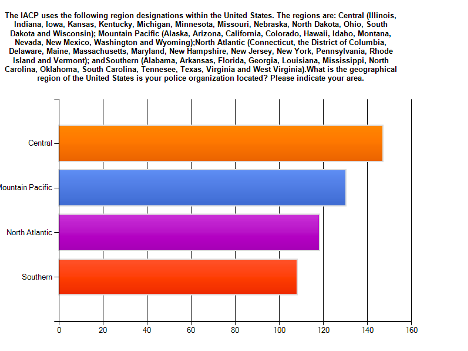
Data Analysis
The data collected were analyzed using the Statistic Package for Social Science (SPSS) with prearranged separation of the data. Agencies were categorized by number of sworn members, the number of preemployment testing measures, and the number of disciplinary and termination actions that have resulted in the ten year period using their preemployment process. A predetermined numeric score was assigned to each preemployment testing procedure used by each agency. The number was then used for comparison against the number of ethical violations and terminations reported by the participant.
The hypothesis that the preemployment testing using the selection process (psychological, background investigations, written entrance exam, truthfulness and medical testing) will reduce the number of ethics violations and terminations of hired police officers was tested by comparing the number of ethical violations and terminations in the group of agencies that use no preemployment tests to those that use all five preemployment tests. A correlational research technique was used to examine a relationship between two or more variables investigating the surface relationship.
The testing technique employed was not to probe for causal reasoning, but correlation only. Both parametric and non-parametric statistics were calculated to identify statistically significant differences between the two groups. Parametric statistics are based on certain assumptions about the nature of the population and that the population is evenly distributed. This is not the assumption of the non-parametric statistic which may be better suited to identify direction and used with ordinal data or when the data is severely skewed. The specific analysis technique engaged in this study is explained in greater length in Chapter 4 of the original study, but not relevant for this discussion. Additionally, descriptive demographic information is used to establish comparability of the two groups to eliminate the possibility of contaminating variables such as geographic location or size of the agency.
The hypothesis asserts that an increase in the number of prescreening tests will be associated with a decrease in the number of ethical violations and terminations of post-hire police officers. The first and second research questions address whether the type and number of prescreening test is differently associated with number of ethical violations resulting in disciplinary action or termination. The third research question addresses best practices of preemployment screening of police officer candidates. A correlational analysis was the primary statistical test used to determine the relationship between the types of prescreening tests (psychological, medical, background investigation, psychological or entrance exam) and the number of ethical hearings and terminations. In the event an inverse direction was determined in the initial analysis, a regression technique would have been applied to determine strength of the relationship.
Additionally, this research provides a rich data set of descriptive statistics describing the components of the police background investigations and the personality and behavior components of the psychological testing used. Demographics of the police organizations collected include allocated sworn strength, geographical region of the USA, and, police organization designation.
The researcher solicited an independent analyst to enter the data from the study using SPSS in order to preclude inferences of data manipulation on the part of the researcher. Survey Monkey provided the descriptive analysis of testing mechanisms and demographics.
Instrument
Participants were sent a self-reporting questionnaire online administered through SurveyMonkey. The instrument targets the identified sample group. The survey questions attempts answers for the research questions using proper analysis and due to the uniqueness of this study the validity of the instrument will not be known until the instrument is used in other research; all research is knowledge (Personal Communication, Andrew Ryan, PhD, March 2, 2012; Susan Gray, PhD, February16, & 27, 2012). The survey instrument is researcher developed for this study and was reviewed by participating experts within the police field, establishing face validity of the instrument.
Variables included types of preemployment tests used for psychological evaluation and duration (predicting individual make-up and if he/she is a fit for law enforcement); types of truth verification tests and duration (polygraph, voice stress analysis, or other examination); types and duration of background investigations (seeking critical competent information divulging social evolution of the candidate); medical and physical agility skills testing (determine capability to perform the essential job functions); and criteria and timing of a decision to conduct a psychological examination provided (after conditional offer of employment or as part of the background investigation). The following charts are of the type of testing provided to candidates and type of agency.
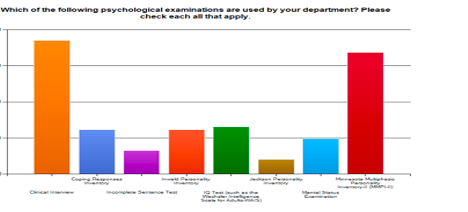
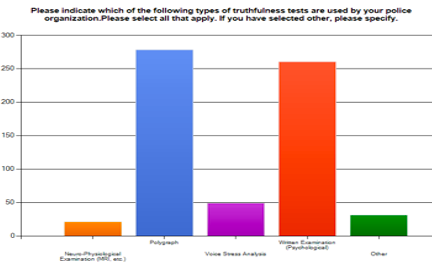
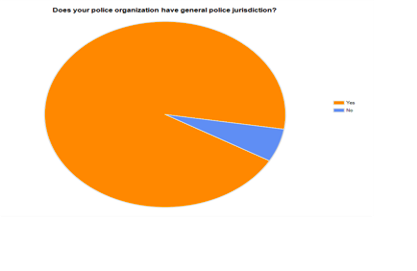
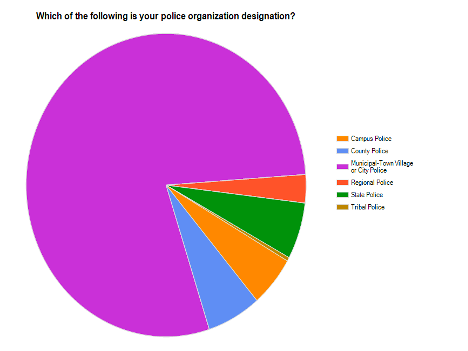
The data collected was used to test the hypotheses stated predicting the correlational relationships of independent variables impact and the dependent variables. The results of the study are intended to provide a best practice model based on empirical evidence establishing a significant relationship between preemployment testing and ethical behavior of police officers. Subjected to correlational analysis data were insufficient to reject the null hypothesis or to support the alternative hypothesis and therefore further testing was unwarranted at this juncture as illustrated in the limitation section.
The validity of the questionnaire is determined from three forms of validity: content validity, criterion-related validity, and construct validity. In a questionnaire, content validity assesses whether the questions cover the range of behaviors normally considered to be part of the area being assessed; construct validity may be recognized by demonstrating that the results of the questionnaire agree with predictions; and criterion-related validity of the questionnaire involves correlating the questionnaire’s results with those from another recognized measure (Creswell, 2009; Leedy &Ormrod, 2010; and Bordens & Abbott, 2011).
Essential to systematic research is the control of internal and external validity. Internal validity refers to those portions of the study that may interfere with the cause-effect among the independent and dependent variable (Glicken, 2003). Other concerns impacting the internal validity, test-wiseness or knowing how to take a test of police officer candidates could be alleviated through the multiple testing processes of police candidates. There could be other influences which could impact the testing results of the police officer candidate during an actual preemployment testing process. This is not a significant methodological concern for this dissertation because the questionnaire is completed by the proper sample group (Police Chiefs) acting as informants on the types of testing performed in their agency and the number of ethical violations resulting in discipline or termination. Each item on the survey is clearly worded removing ambiguity in defining ethics or a violation resulting from abridging ethics. To increase confidence in construct validity the questionnaire was field tested by experts within a NPCO research committee. Comments were received and the questionnaire was amended prior to distribution of the actual survey being conducted.
Feasibility
The problems anticipated in survey completion by the law enforcement executive requiring additional research for certain existing documents including the possibility of needing to request additional information from the Human Resources component of the agency was apparently not an issue as demonstrated by the response rate. In the case of psychological testing, the executive may have needed to obtain additional information from the psychologist that administered the evaluation; however this too did not appear to hamper participant completion of the survey instrument. The anticipated survey completion was 250 agencies, but again due to the interest in this study the size of the sample did not suffer a reduction but rather a significantly greater response of actual N=609.
As part of the ongoing professional efforts, this study supports the efforts of law enforcement executives to provide public security through processes to obtain the most credible personnel. The benefits as already provided should be obvious to the participants of the study; however the greatest benefactor will be the research community. The limitations expressed will provide avenues for future research. The final study analysis will be shared with the participants and the NPCO for benefit of all law enforcement.
The results of this investigation cannot statistically reject the proposed null hypothesis and is unable to support the alternative hypothesis. It does provide meaningful quantitative data that adds to the existing body of knowledge relative to police unethical behavior. The present study demonstrates that increased preemployment screening of police officers by means of the measures discussed in this study will have an increase on the number of unethical hearings and terminations rather than a negative impact as originally hypothesized. In other words greater preemployment testing of police officer candidates will result in a greater number of ethical hearings and terminations. This information gleaned from the study and the works of Sklansky (2006) demonstrates that today’s members of police agencies are less likely to look the other way. They will report the incidents of substantial magnitude but may remain silent on minor matters. Inferences from this study are statistically agreeable in a bond between the individual, the police structure, while exhibiting a departure of old police subcultures, and an allegiance to noble cause corruption summarized in the discussion.
The outcome of this research stresses the importance of the scholarly works cited in the original study. Of significance is data that indicates a shrinking of the “Blue Wall of Silence” or the interaction of organizational influences and individual factors that may result in lapses of ethical judgment. Police officers who feel the system in which they are employed is just and fair will report ethical violations.
Explicitly stated throughout the first three chapters of the original research is that no single cause for unethical behavior exists. A covenant between the individual, the organization structure and the police subculture establishes conditions in which police misconduct can occur. The sociological vetting methodologies of police organizations were measured as the focus of the study, although the police subcultures and organizational structure cannot be discounted. Conclusions of this study illustrate the need for police organizations to continually introduce ethical police officers into the membership in order to further erode the long standing police culture and misconduct that has been condoned through “Noble Cause Corruption”.
Results detailed in this research are plausible, particularly as concluded by Sklansky (2006) that the police departments of the 1950s and 1960s are not reflective of today’s police departments. In Sklansky’ s research the integration of personnel through diversification is tantamount to change in police departments, further diminishing the “Blue Wall of Silence”. Sklansky provides three main categories of hiring within police departments that are primarily responsible for the breakdown of this wall of silence. They are race, gender and sexual preference. He is further resolved that the monolithic police subculture is slowly disappearing due in part to social fragmentation of police membership through court sanctioned diversification and the generational differences removing personnel from the old cry “it’s all about the job” (Sklansky, 2006). His research attributes departmental changes to the competency of new members, the effects the community and police share as a result of diversification and the altering of organization internal dynamics. The social fragmentations within the rank and file membership of police departments today is a departure from the past primarily due to diverse membership being sought by police professional and fraternal organizations formed based on gender, ethnicity, or sexual preference (Sklansky, 2006).
These factors has aided the decline of insularity of the membership where homage and loyalty was once limited to a police bargaining unit such as the Fraternal Order of Police or The Police Benevolent Association. Police officers today maintain interests outside of police work rather than the memberships being solely about “the Job” (Sklansky, 2006; Salahuddin, 2010). Today’s police officer has a life after shift work and they will judge the fairness level of the agency of which they are a member to determine what and how much misconduct will get reported.
A study by Wolfe & Piquero (2011) of the Philadelphia Police Department provides an explanation of police misconduct, more specifically the organizational justice system as it is perceived by police. This examination of the Philadelphia Police Department depicts how personnel view the organization in structure and fairness of disciplinary application. The study included a random survey of 483 police officers employed by the Philadelphia Police Department. The results show that police officers who view their department as fair and just in its managerial practices are less likely to involve themselves in police corruption or hold fast to the code of silence or unethical behaviors such as noble cause corruption. If fair and equitable managerial procedures are practiced consistently, the more likely misconduct will result in an officer’s willingness to report (Wolfe & Piquero, 2011).
Chappell and Piquero (2004) claim that a deviant peer association is an important factor in predicting police misconduct. These authors suggest that officers, who associate with peers demonstrating deviant behavior, are themselves more likely to subscribe to the code of silence. These points are critical within the framework and conclusions of this study. Police leadership must import into the rank and file only the most ethical police officer in order to prevent contamination of peers.
Adams, Tashchian and Shore (2001) argue that structural influences can predict individual ethical behavior and moral decisions made in organizations. They also maintain that unethical and deviant behavior may be the result of situational factors that are as equally important as individual characteristics. Still, it remains their contention that ethical lapses in behavior are better explained as a merger of individual and organizational makeup rather than as independent elements (Adams et al., 2001). The concept that police corruption may be the result of social structure and police department malady is not a new proposition (Sechrest and Burns, 1992). These scholars suggest that ethical persons may have an ethical lapse of judgment as a result of life situations.
This more complex explanation is further supported by Gottschalk (2011). His work puts forward police management’s responsibility to examine both the rotten-apple (individual) and the rotten-barrel (systemic issue) because police misconduct has consequences for both. Therefore controlling the misconduct within a police organization requires examination of the individual and systemic concerns because corrupt cops are made, not born (Gottschalk, 2011). Police leadership must be able to simultaneously direct and lead across multiple generations; generations with differing values and having differing outlooks on what is right (Salahuddin, 2010). These scholars provide an avenue to better understand today’s police department member. Collectively they suggest through a general agreement for concerted attention to establishing an ethical environment for attracting the ethical individual, adhering to ethical organizational practices, and the elimination of unethical police subculture.
Research conducted by Whitman (2013) adds to the existing body of knowledge supporting the importance of examining both the individual and the system, which are not mutually exclusive. His work exercises the opportunity to combine methods to provide a more ethical candidate rather than merely justifying misconduct a single bad apple or a bad barrel approach for assigning culpability for unethical conduct.

